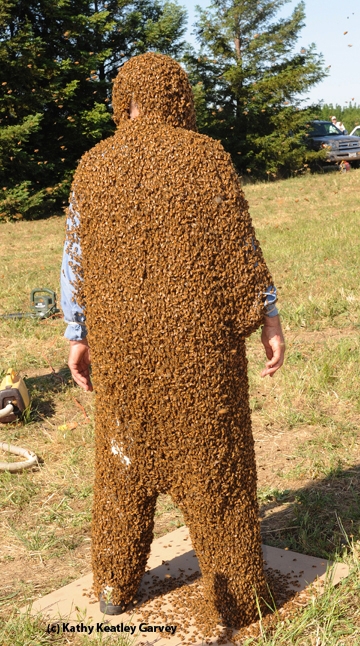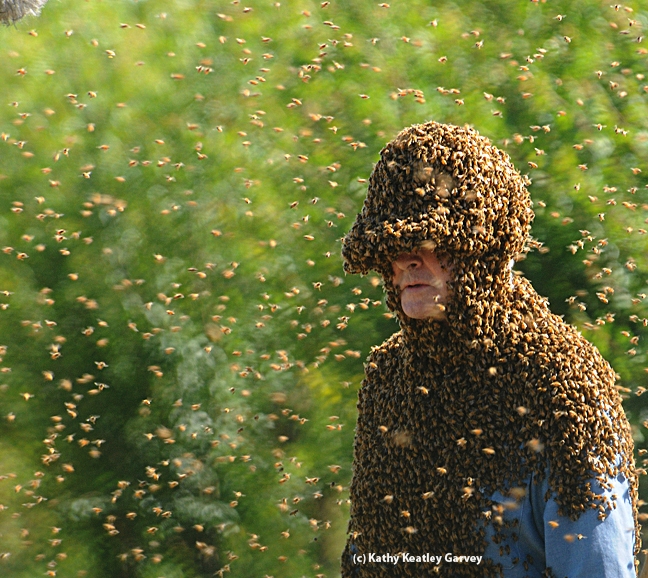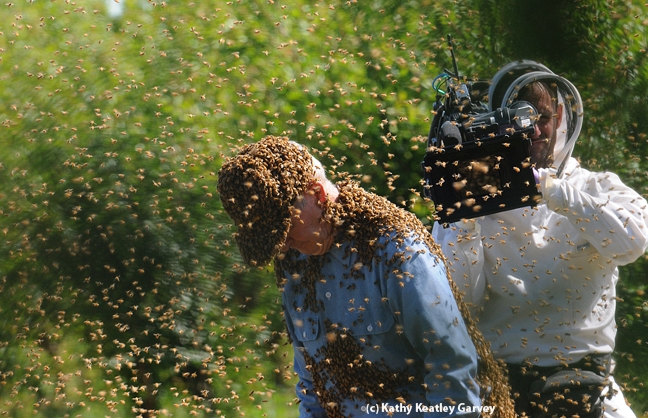
UC ANR Vice-President Barbara Allen-Diaz promises to wear bees—honey bees—if she can raise $2500 by Thursday, Oct. 31 for the UC Promise for Education, a fundraising project to help needy UC students. See her promise page to donate.
Veteran professional bee wrangler Norm Gary, UC Davis emeritus professor of entomology, promises to come out of retirement (he retired from bee wrangling, academic service and beekeeping) to assist with the project.
If all goes well—that is, if Allen-Diaz can raise $2500 by Oct. 31--this bee stunt will take place next spring at the Harry H. Laidlaw Jr. Honey Bee Research Facility on Bee Biology Road, west of the central UC Davis campus.
However, if she raises $5000, she will eat insects or insect larvae. Entomophagy!
We asked senior museum scientist and world traveler Steve Heydon of the Bohart Museum of Entomology if he has any insect-eating recommendations.
He does.
“Crickets,” he said. “Fresh-roasted crickets. They’re really good with a little salt.”
What about termites? “Termites don’t have that much of a taste,” Heydon said.

If Barbara Allen-Diaz needs a little practice, she can enjoy some insect-embedded lollipops available at the gift shop at the Bohart Museum, Room 1124 of the Academic Surge building on Crocker Lane. The choices are crickets, ants and scorpions. Heydon says the lollipops are especially popular as Christmas stocking stuffers. Cost? $3 each.
Butterfly expert Art Shapiro, distinguished professor of evolution and ecology at UC Davis, has eaten butterflies, including Cabbage Whites (Pieris rapae). “I’ve eaten several to see if they’re edible to me, ‘though I’m not a bird. They are (edible), but I prefer fried grasshoppers. Yum!"
And what do Cabbage Whites taste like? “Toilet paper,” Shapiro said.
“My former student Jim Fordyce--he has a background in chemical ecology--used to say that he would never work on a bug he hadn't tasted,” Shapiro related. “However, he did work on the Pipevine Swallowtail, which sequesters the two aristolochic acids, which are mutagenic, carcinogenic and can apparently cause kidney atrophy. So I hope he never swallowed it. Fortunately, it tastes awful, or so I hear--I haven't tried it. Female European Large Whites (Pieris brassicae) are somewhat unpalatable and may be the basis of a loose mimicry ring. Larvae of the Large White are gregarious, inedible and smell like spoiled corned beef and cabbage."
According to Wikipedia, more than 1000 species of insects “are known to be eaten in 80 percent of the world’s nations.” Wikpedia lists some of the most popular insects as crickets, cicadas, grasshoppers, ants, various beetle grubs (such as mealworms), the larvae of the darkling beetle, various speces of caterpillars, scorpions and tarantulas.
Barbara Allen-Diaz hasn't indicated which insect or insect larvae she will select, but oh, the choices!
But first...the bee promise!
Attached Images:

